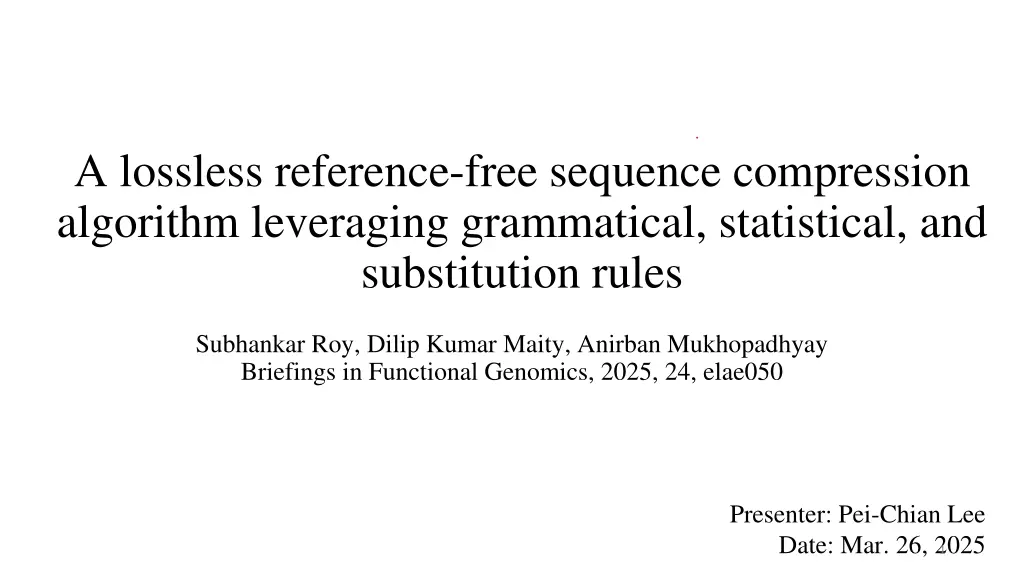
Efficient Lossless Sequence Compression Algorithm - GraSS Methodology
"Discover a novel lossless sequence compression technique, GraSS, leveraging grammatical, statistical, and substitution rules for DNA and RNA sequences. This algorithm outperforms traditional compressors, achieving impressive compression ratios with competitive decompression, memory, and CPU usage."
Download Presentation

Please find below an Image/Link to download the presentation.
The content on the website is provided AS IS for your information and personal use only. It may not be sold, licensed, or shared on other websites without obtaining consent from the author. If you encounter any issues during the download, it is possible that the publisher has removed the file from their server.
You are allowed to download the files provided on this website for personal or commercial use, subject to the condition that they are used lawfully. All files are the property of their respective owners.
The content on the website is provided AS IS for your information and personal use only. It may not be sold, licensed, or shared on other websites without obtaining consent from the author.
E N D
Presentation Transcript
A lossless reference-free sequence compression algorithm leveraging grammatical, statistical, and substitution rules Subhankar Roy, Dilip Kumar Maity, Anirban Mukhopadhyay Briefings in Functional Genomics, 2025, 24, elae050 Presenter: Pei-Chian Lee Date: Mar. 26, 2025 1
Abstract (1/2) Deoxyribonucleic acid (DNA) or ribonucleic acid (RNA) sequence compressors for novel species frequently face challenges when processing wide-scale raw, FASTA, or multi-FASTA structured data. For years, molecular sequence databases have favored the widely used general-purpose Gzip and Zstd compressors. The absence of sequence-specific characteristics in these encoders results in subpar performance, and their use depends on time-consuming parameter adjustments. To address these limitations, in this article, we propose a reference-free, lossless sequence compressor called GraSS (Grammatical, Statistical, and Substitution Rule-Based). GraSS compresses sequences more effectively by taking advantage of certain characteristics seen in DNA and RNA sequences. It supports various formats, including raw, FASTA, and multi-FASTA, commonly found in GenBank DNA and RNA files. We evaluate GraSS s performance using ten benchmark DNA sequences with reduced number of repeats, two highly repetitive RNA sequences, and fifteen raw DNA sequences. Test results indicate that the weighted average compression ratios (WACR) for DNA and RNA sequences are 4.5 and 19.6, respectively. Additionally, the entire DNA sequence corpus has a total compression time (TCT) of 246.8 seconds (s). 2
Abstract (2/2) These results demonstrate that the proposed compression method performs better than several advanced algorithms specifically designed to handle various levels of sequence redundancy. The decompression time, memory usage, and CPU usage are also very competitive. 3
First Phase Example 1. seq1.fa >chr ATTGCATGTcgatggATGGggaAAA ATCGataggatAGATTTTTAAAACC CNNNNYYY The following are included in the preprocessed output from file seq1.fa: Sequence identifier (F2): >chr; Lower case tuple (F2): (9, 6), (4, 3), and (7, 7); -> run-length encoding Special character tuple (F2): (55, 24), (1, 24), and (1, 24); -> delta encoding Line length (F2): 25; Block length (F2): 58; Sequence (F1): ATTGCATGTCGATGGATGGGGAAAA 5 ATCGATAGGA TAGATTTTTAAAACCCNNNN
Second Phase step 1 Calculating the frequency of appearance of the letters A, C, G, T, and N in the previously stated sequence S: Freq(A)=50 Freq(C)=14 Freq(G)=10 Freq(T) = 80 Freq(N) = 4 6
Second Phase step 2 Determining the first three letters that appear the least frequently: Small(Freq) = Freq(N) = 4 SndSmall(Freq) = Freq(G) = 10 TrdSmall(Freq)= Freq(C)=14 Freq(A)=50 Freq(C)=14 Freq(G)=10 Freq(T) = 80 Freq(N) = 4 7
Second Phase step 3 Freq(A)=50 Freq(C)=14 Freq(G)=10 Freq(T) = 80 Freq(N) = 4 Rule 1 = {N ZZ, G ZT, C ZA} ATTGCATGTCGATGGATGGGGAAAA ATCGATAGGA TAGATTTTTAAAACCCNNNN ATTZTZA ATZTTZAZTATZTZTATZTZTZTZTAAAAATZAZTATAAT AZTATTTTTAAAAZAZAZAZZZZZZZZ ... 8
Second Phase step 4 Freq(A)=50 Freq(C)=14 Freq(G)=10 Freq(T) = 80 Freq(N) = 4 Rule 2 = {T 0, A 1, Z 2} ATTZTZA ATZTTZAZTATZTZTATZTZTZTZTAAAAATZAZTATAAT AZTATTTTTAAAAZAZAZAZZZZZZZZ ... 1002021102002 120102020102020202011111021201011012010000011 1112 1212122222222... 9
Second Phase step 5 Rule 3 = {00 P,01 Q,10 R, 02 S,20 U,11 V,12 W,21 X,22 Y} 1002021102002 120102020102020202011111021201011012010000011 1112 1212122222222... Freq(A)=50 Freq(C)=14 Freq(G)=10 Freq(T) = 80 Freq(N) = 4 RSSVSPXURUURUUUUVVRXURVQURP PVVW WWYYYY... 10
Second Phase step 6 The last phase uses block-sorting encoding (BSC) to encode the intermediate data. 11
Result FASTA DNA raw DNA FASTA RNA 12
Result raw DNA FASTA DNA 13
